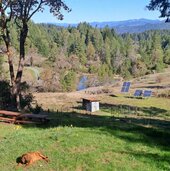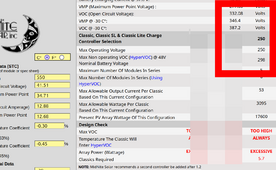ddxv
New Member
I have panels that at a maximum would be max 67amps and 80amps including bifacial. The Ampacity chart shows that 80 is a bit close to 75c. Additionally, my calculation is that I would see 10.09v 8% voltage loss across the 300 feet from panels to Midnite Solar Classic 250 MPPT charge controller/batteries.
Setup:
8 old panels:
Watts: 295
Vmp: 36.5
Volts in Series: 146
16 new panels:
Watts: 440, bifacial 550
Vmp: 34.71
Volts in Series: 138.84
The total at source:
Old panels amps: 16
New Panels amps: 50 (normal) 63 (+bifacial)
Total amps: 66, 80 (+bifacial)
New panels spec sheet if needed:
https://signaturesolar.com/aptos-44...to-550w-with-bifacial-gain-dna-120-bf10-440w/
Setup:
8 old panels:
Watts: 295
Vmp: 36.5
Volts in Series: 146
16 new panels:
Watts: 440, bifacial 550
Vmp: 34.71
Volts in Series: 138.84
| Name | Strings | Series | Panel Count | VMPP | Volts From Panels |
| old panels | 2 | 4 | 8 | 36.5 | 146 |
| new panels | 4 | 4 | 16 | 34.71 | 138.84 |
The total at source:
Old panels amps: 16
New Panels amps: 50 (normal) 63 (+bifacial)
Total amps: 66, 80 (+bifacial)
New panels spec sheet if needed:
https://signaturesolar.com/aptos-44...to-550w-with-bifacial-gain-dna-120-bf10-440w/
Last edited:





